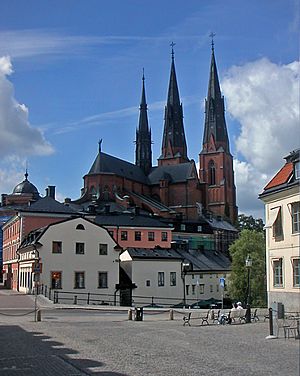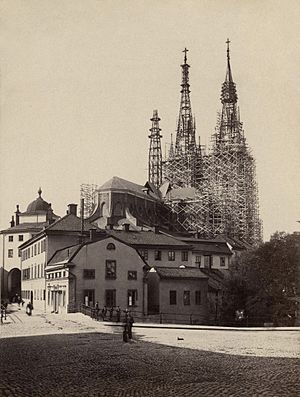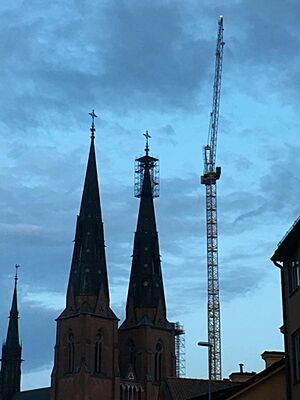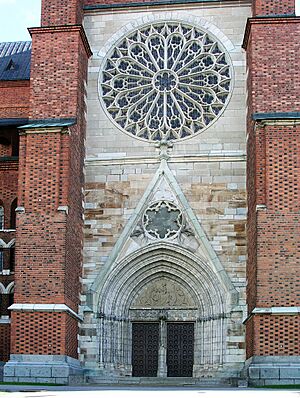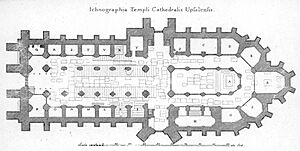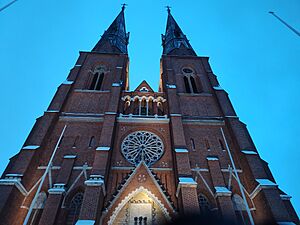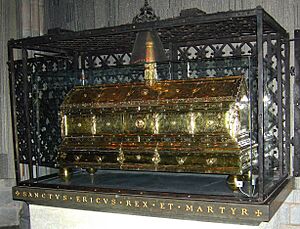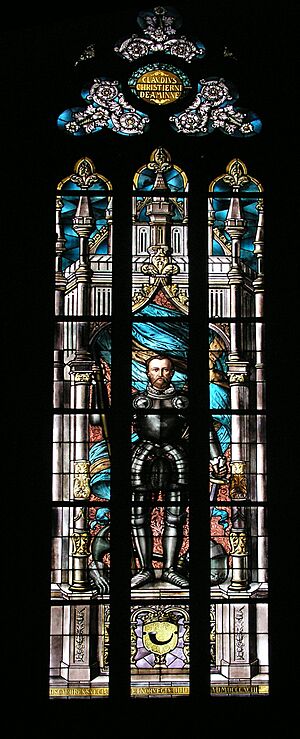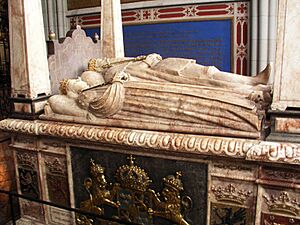Uppsala Cathedral facts for kids
Quick facts for kids Uppsala Domkyrka |
|
|---|---|
| The Metropolitan Cathedral Church of Uppsala | |
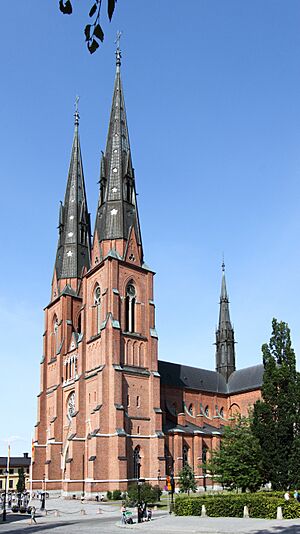
Uppsala Cathedral from the southwest
|
|
| Location | Uppsala, Uppland |
| Country | Sweden |
| Denomination | Church of Sweden |
| Previous denomination | Roman Catholic |
| History | |
| Authorising papal bull | 1258 |
| Status | Cathedral, National shrine |
| Dedication | Saint Lawrence, Saint Eric, Saint Olaf |
| Consecrated | 7 June 1435 |
| Relics held | Saint Eric, Saint Bridget |
| Architecture | |
| Functional status | Active |
| Style | Gothic |
| Years built | 1272–1893 (last major alteration) |
| Specifications | |
| Length | 389 feet (119 m) |
| Width | 148 feet (45 m) |
| Nave height | 89 feet (27 m) |
| Number of towers | 2 |
| Number of spires | 3 |
| Spire height | 389 feet (119 m) |
| Administration | |
| Archdiocese | Uppsala |
Uppsala Cathedral (Swedish: Uppsala domkyrka) is a huge church in the city of Uppsala, Sweden. It stands between the Uppsala University and the Fyris river. This amazing building is part of the Church of Sweden, which follows the Lutheran tradition.
The cathedral is the main church for the Archbishop of Uppsala, who is the most important leader of the Church of Sweden. It's also the resting place of King Eric IX, who lived in the 1100s and became Sweden's patron saint. For a long time, new Swedish kings were crowned here. The current archbishop is Martin Modéus, and the bishop is Karin Johannesson.
This cathedral was started in the late 1200s. It stands at 118.7 metres (389 ft) tall, making it the tallest church in all the Nordic countries. It was first built for the Roman Catholic Church. After the Protestant Reformation, it became a place where Swedish kings were crowned for many years. Some of its smaller rooms were turned into tombs for kings like Gustav Vasa and John III. Famous people like Carl Linnaeus, Olaus Rudbeck, and Emanuel Swedenborg are also buried here.
The church was designed in the French Gothic style by French architects, including Étienne de Bonneuil. It looks like a Latin cross from above, with a long main hall (nave) and two shorter arms (transepts). Most of the building was finished between 1272 and 1420. The two tall towers at the front were added later. After a big fire in 1702, the towers got new, lower tops. Later, in the 1880s, Helgo Zetterwall completely changed their design. The cathedral is mostly made of brick, but its strong pillars and many details are made from Gotland limestone.
The arched ceilings inside were built following the original 13th-century plans. Many old church items can be seen in the Treasury Museum. The 1702 fire destroyed a lot of the church's features. In the 1970s, during a renovation, many old paintings on the walls (called frescoes) were found and fixed. These paintings had been covered up after the Reformation.
Contents
History of Uppsala Cathedral
At the end of the Viking Age, a Christian church replaced an old pagan temple in Gamla Uppsala (Old Uppsala). This was about 5 kilometres (3.1 mi) north of today's Uppsala. In 1164, Sweden got its own archbishop, Stefan of Alvastra.
After the church in Gamla Uppsala was damaged by fire in 1204, church leaders asked the Pope if they could move the main church to a bigger place. Pope Alexander IV agreed in 1258, as long as the name "Uppsala" was kept. In 1270, it was decided that the new church would be built in Östra Aros, which is where modern Uppsala is now.
Around 1272, work began on the new cathedral in Östra Aros, near the Fyris River. It was built on the spot of an older stone church. This was the place where Sweden's patron saint, Eric Jedvardsson, had attended church before he was killed in 1160. The name Uppsala was kept, and Östra Aros soon became known as Uppsala. In 1273, Saint Eric's important relics (holy items) were moved from Gamla Uppsala to the new church.
French architects designed the church. One of them, Étienne de Bonneuil, came to Sweden in 1287 to help with the building. Building was slow because of the cold weather, diseases, and money problems. The main plans were not finished until the late 1300s.
When the cathedral was officially opened in 1435 by Archbishop Olaus Laurentii, it was still not fully complete. It was dedicated to three saints: Saint Lawrence, Saint Eric, and Saint Olaf. The last main parts of the cathedral, the towers, were built between 1470 and 1489. The cathedral was damaged by fire many times, especially in the big fire of 1702 that destroyed much of Uppsala. Repairs took many years.

Before the Protestant Reformation, ordinary people didn't usually worship in the cathedral. It was mainly for official church services. Other churches in Uppsala were used by the local people. The cathedral was also the place where many Swedish kings and queens were crowned until 1719. After that, Stockholm's Storkyrkan became the official coronation church.
From 1885 to 1893, architect Helgo Zettervall led a big restoration project. He wanted to make the cathedral look more like a French High Gothic church. He added pointed French spires to the towers, making the cathedral as tall as it was long, at 118.7 m (389 ft). Zettervall also changed many of the old brick walls.
More renovation work in the early 1970s made the building stronger. In 1989, Pope John Paul II visited Uppsala Cathedral for a special service. Fire safety systems were put in place in 2010, and the heating and electrical systems were updated.
Between 2019 and 2021, the cathedral's twin spire crowns and crosses were fully restored. These parts, which were 10 meters tall and weighed 4.2 tons, were installed in 1889. They were showing signs of rust and cracks. The restoration involved removing the old parts and making new ones from modern, stronger iron. The new parts look just like the originals but are more durable. The spires were put back in place in May 2021, and the project was finished in autumn 2021.
Cathedral Architecture
Uppsala Cathedral is the tallest church in Scandinavia. It is 118.7 m (389 ft) tall and also 118.7 m (389 ft) long, with a width of 45 m (148 ft). Inside, the height is 27 metres (89 ft). French builders designed the church in the French High Gothic style.
The church is built on a gravel ridge. Its floor plan looks like a Latin cross. It has a main hall (nave) with two side aisles, and two shorter arms (transepts). There's also a choir area with five chapels around it. The main hall has chapels along its sides. Most of the church was built between 1270 and 1420. The main material is red brick, but the strong pillars and many details are made of Gotland limestone.
The two towers at the west end of the church were first mentioned in 1563. After a fire in 1572, more parts were added to the church. In the 1690s, Nicodemus Tessin designed a new burial chapel. From the outside, it looked Gothic, but the inside was in his usual fancy Classical Baroque style.
In the 1600s, the towers were changed to a Dutch Renaissance style. But after the big fire of 1702, they were replaced with simple wooden tops. In 1740, new copper-covered spires were added, designed by Carl Hårleman. Today's tall towers are the work of Helgo Zettervall, who rebuilt them in the 1880s.
Even though French architects designed it, Uppsala Cathedral is different from French cathedrals. It's mostly made of brick, not stone, because brick was easier to get locally. Since brick isn't as strong as stone, the walls had to be thicker. The north transept entrance, with its beautiful rose window, is made of limestone.
The choir and transept clearly show French design. However, the nave, built later, has German and Swedish features. The rose window above the northeast entrance, built around 1330, is still completely French. A Swedish builder named Nikolaus from Västerås changed the plans slightly in the 1360s, adding side chapels. Overall, Uppsala Cathedral still looks like the 13th-century cathedrals of northern France.
Inside the Cathedral
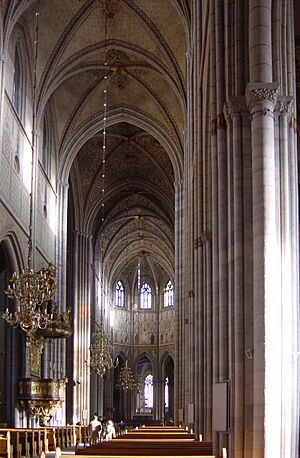
The Coronation Vault is 27 m (89 ft) above where the main hall and transept cross. This is where most Swedish kings and queens were crowned until 1719. During the 1880s renovation, the inside of the cathedral was decorated in a Neo-Gothic style. Some new pictures, like one of Martin Luther, were added. In the 1970s, many old medieval paintings (frescoes) that had been covered up were found and restored.
The high altar is used for important church services. All Swedish bishops are ordained here. The silver chandelier is from 1647. A large crucifix made of silver and crystal was added in 1976.
Cathedral Chapels
The largest chapel, the Vasa Chapel, is at the eastern end of the church. It was once called the Chapel of the Virgin Mary. Later, it became a burial place for Gustav Vasa and his family. It was finished in 1583 and is decorated with Sweden's national symbols.
The Finsta Chapel, or St Eric's Chapel, holds the relics of Eric the Holy. He was killed in 1160 on the spot where Uppsala Cathedral was later built. His shrine was moved from Gamla Uppsala to the new church. In 1580, King John III replaced his old shrine with a new gold-plated one, which still holds Eric's relics and crown. The Finsta name comes from the estate where Judge Birger Persson and his wife were born. They were buried here in 1328. A small relic of their daughter, Saint Bridget, was given to the chapel in 1990.
Next to the Finsta Chapel is the Sture Chapel. This is the tomb for three members of the Sture family who were killed by King Eric XIV in 1567. The altar screen (from 1520) shows the story of Mary's parents, Anne and Joachim. In the late 1500s, the church's sacristy (a room for church items) was turned into a burial chapel for Queen Catherine Jagiellon, wife of King John III. She is also buried there. This chapel is called the Jagellonica Chapel after her.
Stained-Glass Windows
Many windows in the cathedral still have their original shape. Most of the old stained-glass windows were destroyed in the 1702 fire and replaced with plain glass. The beautiful stained-glass designs you see today were added during the renovation in the late 1800s. The large windows above the entrances show the Trinity: God the Father above the west door, God the Son above the south door (the biggest window), and God the Holy Spirit above the north door. The rose window at the north entrance, made of limestone, is the oldest, unchanged since the 1200s.
Treasury and Artworks
The Treasury Museum, located in the north tower, has many gold and silver items used in church services. It also has a collection of old clothes, including Queen Margaret's golden gown. You can also see the burial clothes of Gustav Vasa, John III, and their wives.
Other important items in the cathedral include tapestries (woven pictures) in the Chapel of Remembrance from 1976. These show important events in the cathedral's history. The fancy pulpit (from 1710), which is the largest in Sweden, was designed by Nicodemus Tessin. It was a gift from Queen Hedvig Eleonora after the 1702 fire. It shows scenes like John the Baptist preaching.
One of the new bells installed after the 1702 fire is called Thornan. It was taken from Toruń, Poland, as a war prize in 1703 by Swedish forces during the Great Northern War.
In the Vasa Chapel, there are seven large fresco paintings by Johan Gustaf Sandberg (1782–1854). They show important moments in the life of Gustav Vasa. One famous painting is Speech to the people of Dalarna outside Mora Church. Frescoes also decorate the arched ceilings of the main hall.
Originally, the inside of the cathedral had designs that highlighted the arches and entrances. Even the bricks were painted with red and white stripes. In the 1400s, paintings of figures in a Late Gothic style were added. Traces of these have been found and restored. The paintings in the choir were likely done by artists from Albertus Pictor's workshop.
Famous People Buried Here
Many important Swedish kings and other famous people are buried inside Uppsala Cathedral:
- Gustav Vasa, a 16th-century King of Sweden. He is buried with his three wives in what was once the Chapel of the Virgin Mary.
- John III (died 1592), Gustav Vasa's second son, and his second wife Gunilla Bielke are also buried in the Virgin Mary Chapel. His first wife, Catherine Jagellon, has her own burial chapel.
- Princess Elizabeth (died 1597), Gustav Vasa's youngest daughter, is buried in the Finsta Chapel.
- The noblemen Svante Sture (1517–1567) and his sons Nils (1543–1567) and Erik (1546–1567) were all killed by King Erik XIV. They are buried in the Sture Chapel. Their clothes from that day are in the Treasury Museum.
- Carl Linnaeus (1707–1778), the world-famous botanist and professor at Uppsala University, has a memorial here.
- Charles De Geer (1720–1778), an industrialist and scientist who studied insects.
- Olaus Rudbeck, a Swedish scientist who helped discover the lymphatic system.
- Emanuel Swedenborg, an 18th-century scientist and spiritual thinker. His remains were moved here from England in 1908.
- Nathan Söderblom (1866–1931), an archbishop of Uppsala and winner of the Nobel Peace Prize.
- Eric the Saint, a 12th-century king and national saint, whose relics are in the Finsta Chapel.
- Laurentius Petri (1499–1573), Sweden's first Lutheran archbishop.
- Relics of Saint Bridget (1303–1373) are in a shrine in the Finsta Chapel.
- Folke Johansson Ängel, Archbishop of Uppsala (1267–1277).
Dag Hammarskjöld Memorial
There is a small memorial in the cathedral for Dag Hammarskjöld. He was a former Secretary-General of the United Nations and won the Nobel Peace Prize after he passed away. A stone has this inscription:
- Icke jag
- utan Gud i mig
- Dag Hammarskjöld 1905 – 1961
In English, this means "Not I, but God in me."
Visiting the Cathedral
The cathedral is located in the center of Uppsala. It is usually open to visitors most days from 8 am to 6 pm. The Treasury Museum in the north tower is open from 10 am to 4 pm, and on Sundays from 12:30 pm.
See also
 In Spanish: Catedral de Upsala para niños
In Spanish: Catedral de Upsala para niños
- Archbishop of Uppsala
- Church of Sweden
- Temple at Uppsala
Images for kids


